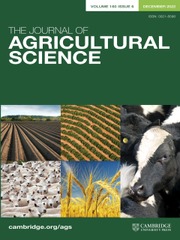Crossref Citations
This article has been cited by the following publications. This list is generated based on data provided by
Crossref.
Hoffmann, Erich
1968.
Biometrischie Probleme der Auswertung von Dauerversuchen.
Archives of Agronomy and Soil Science,
Vol. 12,
Issue. 9,
p.
783.
1974.
Comparative Experiments with Field Crops.
p.
200.
Patterson, H. D.
1976.
Generation of Factorial Designs.
Journal of the Royal Statistical Society Series B: Statistical Methodology,
Vol. 38,
Issue. 2,
p.
175.
Reid, D.
1984.
The seasonal distribution of nitrogen fertilizer dressings on pure perennial ryegrass swards.
The Journal of Agricultural Science,
Vol. 103,
Issue. 3,
p.
659.
Bailey, R.A.
1985.
Factorial design and abelian groups.
Linear Algebra and its Applications,
Vol. 70,
Issue. ,
p.
349.
Preece, D. A.
1986.
Some General Principles of Crop Rotation Experiments.
Experimental Agriculture,
Vol. 22,
Issue. 2,
p.
187.
Bailey, R. A.
Kunert, J.
and
Martin, R. J.
1991.
Some Comments on Gerechte Designs.
Journal of Agronomy and Crop Science,
Vol. 166,
Issue. 2,
p.
101.
Edmondson, R. N.
1993.
Systematic Row-And-Column Designs Balanced for Low Order Polynomial Interactions between Rows and Columns.
Journal of the Royal Statistical Society Series B: Statistical Methodology,
Vol. 55,
Issue. 3,
p.
707.
Street, Deborah J.
1996.
Design and Analysis of Experiments.
Vol. 13,
Issue. ,
p.
759.
Bailey, R. A.
2004.
Encyclopedia of Statistical Sciences.
Bailey, R. A.
2004.
Encyclopedia of Statistical Sciences.
Bailey, R. A.
2005.
Encyclopedia of Statistical Sciences.
Bailey, R. A.
2005.
Encyclopedia of Statistical Sciences.
Bailey, R. A.
2014.
Wiley StatsRef: Statistics Reference Online.
Bailey, R. A.
2014.
Wiley StatsRef: Statistics Reference Online.
Bailey, R. A.
2016.
mODa 11 - Advances in Model-Oriented Design and Analysis.
p.
27.
Kobilinsky, André
Monod, Hervé
and
Bailey, R.A.
2017.
Automatic generation of generalised regular factorial designs.
Computational Statistics & Data Analysis,
Vol. 113,
Issue. ,
p.
311.
Bailey, R. A.
2023.
Research in History and Philosophy of Mathematics.
p.
213.

